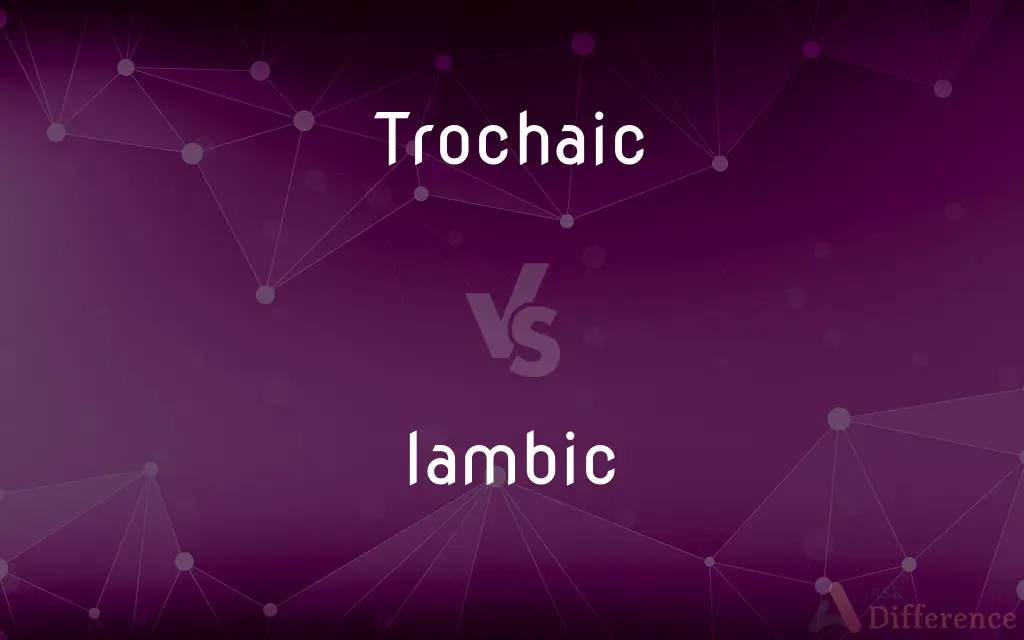Trochaic vs. Iambic — What's the Difference?
By Tayyaba Rehman & Fiza Rafique — Updated on May 9, 2024
Trochaic meter emphasizes a stressed syllable followed by an unstressed one, exemplified in words like "garden," while iambic meter features an unstressed syllable followed by a stressed one, as in "delight."

Difference Between Trochaic and Iambic
Table of Contents
ADVERTISEMENT
Key Differences
Trochaic meter begins with a strong stress followed by a lighter one, creating a falling rhythm that is often used to invoke a more emphatic or solemn tone. Iambic meter, on the other hand, starts with an unstressed syllable and moves to a stressed one, producing a rising rhythm that is typically perceived as more natural and conversational.
In poetry, trochaic meter can lend a percussive and insistent quality to the verse, which is why it is often found in chants and spells within poetry, enhancing their incantatory effect. Conversely, iambic meter, with its smoother and more flowing cadence, is favored in long narratives and dramatic monologues, aiding in the natural flow of speech and storytelling.
Trochaic meter tends to be more straightforward and less varied due to the strong beat starting each foot, which can make extended trochaic lines feel monotonous. Iambic meter is more flexible, allowing variations that can adapt to different tones and complexities within the same piece.
Examples of trochaic meter are found in works like Edgar Allan Poe’s "The Raven," which uses the meter to create a somber and ominous mood. Iambic meter is famously used in Shakespeare’s plays and sonnets, which utilize the meter to mimic the natural rhythms of English speech.
Due to its rhythm, trochaic meter is less common in extended texts compared to iambic meter, which dominates much of English verse, partly due to its versatility and alignment with the natural cadences of the English language.
ADVERTISEMENT
Comparison Chart
Basic Pattern
Stressed followed by unstressed
Unstressed followed by stressed
Common Usage
Spells, chants, short lines
Narrative poetry, plays, long verses
Tone
Emphatic, solemn
Natural, conversational
Variability
Less variation, can be monotonous
Highly flexible, allows for rhythmic variation
Examples
Edgar Allan Poe's "The Raven"
Shakespeare’s sonnets and plays
Compare with Definitions
Trochaic
A metrical foot consisting of a stressed syllable followed by an unstressed syllable.
The poem’s line “LOVely DAY” demonstrates trochaic meter.
Iambic
Mimics natural speech patterns, making it popular in English literature.
The dialogue in the play flowed smoothly thanks to its iambic meter.
Trochaic
Less common in extended narrative poems due to potential monotony.
The poet avoided using trochaic meter in longer sections to prevent repetitive tone.
Iambic
Dominant in much of classic and contemporary poetry.
Modern poets often use iambic meter for its adaptability and ease of reading.
Trochaic
Found in traditional and folk poetry for its rhythmic simplicity.
Many nursery rhymes employ trochaic meter for memorable beats.
Iambic
Versatile, suitable for both dramatic and narrative poetry.
The epic poem was written in iambic pentameter to enhance its lyrical quality.
Trochaic
Can evoke a feeling of declamation or proclamation.
The speaker used a trochaic line to call attention and emphasize his point.
Iambic
Allows for rhythmic variations and subtleties within verses.
The poet skillfully varied the iambic rhythm to highlight emotional shifts.
Trochaic
Often used to create a somber or forceful rhythm.
The chants in the ritual used trochaic words for a strong, rhythmic impact.
Iambic
A metrical foot in poetry where an unstressed syllable is followed by a stressed syllable.
The line “to BE or NOT to BE” in Shakespeare’s work is iambic.
Trochaic
Of, relating to, or consisting of trochees.
Iambic
Consisting of iambs or characterized by their predominance
Iambic pentameter.
Trochaic
Composed of or relating to trochees, feet of one stressed syllable followed by an unstressed syllable.
Iambic
An iamb.
Trochaic
A poetical composition of this kind.
Iambic
Often iambics A verse, stanza, or poem written in iambs.
Trochaic
A trochaic verse or measure.
Iambic
(prosody) Consisting of iambs (metrical feet with an unstressed-stressed pattern) or characterized by their predominance. 16
Trochaic
Of or pertaining to trochees; consisting of trochees; as, trochaic measure or verse.
Iambic
(prosody) An iamb; a line or group of lines of iambs.
Trochaic
Of or consisting of trochees;
Trochaic dactyl
Iambic
Consisting of a short syllable followed by a long one, or of an unaccented syllable followed by an accented; as, an iambic foot.
Iambic
Pertaining to, or composed of, iambics; as, an iambic verse; iambic meter. See Lambus.
Iambic
An iambic foot; an iambus.
Thy gen- | ius calls | thee not | to pur- | chase fameIn keen | iam- | bics, but | mild an- | agram.
Iambic
A satirical poem (such poems having been anciently written in iambic verse); a satire; a lampoon.
Iambic
A verse line consisting of iambs
Iambic
Of or consisting of iambs;
Iambic pentameter
Common Curiosities
Can a poem combine trochaic and iambic meters?
Yes, poets often combine different meters for rhythmic diversity or to emphasize particular sections of their poetry.
What effect does trochaic meter have on the tone of a poem?
Trochaic meter can lend a commanding and sometimes solemn tone to poetry, suitable for chants or dramatic declarations.
What is trochaic meter?
Trochaic meter is a rhythmic pattern in poetry characterized by a stressed syllable followed by an unstressed one.
Why is iambic meter considered more natural in English?
Iambic meter closely mimics the natural rhythm of English speech, making it fluid and easy to adapt in spoken language.
How does the choice of meter influence a poem’s readability?
The choice of meter can greatly affect a poem's readability; iambic meter tends to be smoother, whereas trochaic can be more jarring.
Are there famous poems that use trochaic meter?
Yes, "The Raven" by Edgar Allan Poe is a famous example of trochaic meter.
What is iambic meter?
Iambic meter features an unstressed syllable followed by a stressed one, commonly used across various forms of poetry.
How do poets maintain variety in iambic poems?
Poets introduce variations in an iambic poem by incorporating occasional trochees, spondees, or pyrrhics to break the monotony.
Why might a poet choose trochaic meter for a particular piece?
A poet might choose trochaic meter to create a more pronounced rhythmic effect or to complement the thematic content of the poem.
Which meter is more common in English poetry?
Iambic meter is more prevalent in English poetry due to its versatility and natural flow.
How does Shakespeare utilize iambic meter?
Shakespeare extensively uses iambic pentameter, which enhances the dramatic and rhythmic quality of his plays and sonnets.
Can trochaic and iambic meters be used in the same poem?
Yes, combining these meters can provide contrast and highlight different aspects of the poem’s theme or emotion.
What skills are necessary for writing in iambic meter?
A good sense of rhythm, knowledge of stress patterns in words, and the ability to adapt the meter to the natural flow of language are crucial.
Is trochaic meter suitable for long poems?
Trochaic meter is less commonly used for long poems as it can become monotonous; it is more effective in shorter lines or stanzas.
What are the challenges of writing in trochaic meter?
Maintaining a natural flow while adhering to the stressed-unstressed pattern can be challenging in trochaic meter.
Share Your Discovery

Previous Comparison
Apophenia vs. Pareidolia
Next Comparison
Glee vs. JoyAuthor Spotlight
Written by
Tayyaba RehmanTayyaba Rehman is a distinguished writer, currently serving as a primary contributor to askdifference.com. As a researcher in semantics and etymology, Tayyaba's passion for the complexity of languages and their distinctions has found a perfect home on the platform. Tayyaba delves into the intricacies of language, distinguishing between commonly confused words and phrases, thereby providing clarity for readers worldwide.
Co-written by
Fiza RafiqueFiza Rafique is a skilled content writer at AskDifference.com, where she meticulously refines and enhances written pieces. Drawing from her vast editorial expertise, Fiza ensures clarity, accuracy, and precision in every article. Passionate about language, she continually seeks to elevate the quality of content for readers worldwide.
















































